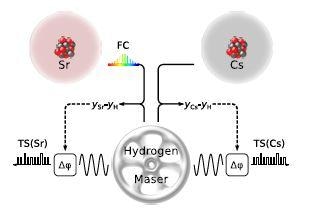May 26 2016
GPS-based navigation, communication systems, electrical power grids and financial networks all rely on the precise time kept by a network of around 500 atomic clocks located around the world.
 The Cs clock transition frequency is compared against the maser flywheel frequency. The acquired offset Cs yH is used to correct the classical timescale TS(Cs) generated from the maser utilizing a phase stepper (Df). Credit: [email protected]
The Cs clock transition frequency is compared against the maser flywheel frequency. The acquired offset Cs yH is used to correct the classical timescale TS(Cs) generated from the maser utilizing a phase stepper (Df). Credit: [email protected]
In The Optical Society's journal for high impact research, Optica, researchers present a way to use optical clocks for more accurate timekeeping than is possible with today's system of traditional atomic clocks. The researchers also measured an optical clock's frequency -- analogous to it's "ticking" -- with unprecedented precision.
A more accurate global time keeping system would allow financial networks to use more precise time stamps and thus handle even more transactions in shorter amounts of time. It would also allow GPS and other satellite-based navigation systems to provide even more precise location information.
Although optical clocks have been more accurate than microwave clocks for some time, their complexity and resulting long downtimes have made it unpractical to use them for worldwide timekeeping.
"We showed that even with the downtimes of today's optical clocks, they still can improve timekeeping," said Christian Grebing, Physikalisch-Technische Bundesanstalt (PTB), The National Metrology Institute of Germany, who is a member of the research team. "We achieved a better performance compared to the very best microwave fountain clocks which have generally been considered less reliable and thus less suitable for the actual implementation of a practical timescale."
How long is a second?
Clocks work by counting a recurrent event with a known frequency, such as the swinging of a pendulum. For traditional atomic clocks, the recurrent event is the natural oscillation of the cesium atom, which has a frequency in the microwave region of the electromagnetic spectrum. Since 1967, the International System of Units (SI) has defined the second as the time that elapses during 9,192,631,770 cycles of the microwave signal produced by these oscillations.
Atomic clocks are extremely accurate because they are based on natural and universal atom vibrations. However, even the best atomic microwave clocks can still accumulate an error of about 1 nanosecond over a month.
Optical clocks work in a manner somewhat similar to microwave clocks but use atoms or ions that oscillate about 100,000 times higher than microwave frequencies, in the optical, or visible, part of the electromagnetic spectrum. These higher frequencies mean that optical clocks "tick" faster than microwave atomic clocks, and this contributes to their higher accuracy and stability over time. However, optical clocks do experience significant downtimes because of their higher technical complexity.
Making optical clocks practical
To deal with the downtimes that plague today's optical clocks, the researchers combined a commercially available maser with a strontium optical lattice clock at PTB, Germany's national metrology institute. The maser, which is like a laser except that it operates in the microwave spectral range, can be used as a type of reliable pendulum with limited accuracy to bridge the downtime of the optical clock. The researchers spanned the large spectral gap between the optical clock's optical frequency and the maser's microwave frequency with an optical frequency comb, which effectively divides the slower microwave-based "ticks" to match the faster "ticks" of the optical clock.
"We compared the continuously running maser with our optical clock and corrected the maser frequency as long as we had data available from the optical clock," said Grebing. "During the optical clock's downtimes, the maser runs on its own stably."
The researchers operated the maser and optical clock for 25 days, during which the optical clock ran about 50 percent of the time. Even with optical clock downtimes ranging from minutes to two days, the researchers calculated a time error of less than 0.20 nanoseconds over the 25 days.
Redefining the second
To redefine a second based on optical clocks not only requires making sure that optical clocks are practical, but it also requires comparing their frequency, or "ticking," to the old definition of the SI second. To do this, the researchers compared their strontium optical clock with two microwave clocks at PTB. Incorporating the maser strongly improved the statistical uncertainty of these measurements, allowing the researchers to measure the absolute frequency of the optical clock's strontium oscillations with the lowest uncertainty ever achieved. The obtained relative uncertainty of about 2.5×10-16 corresponds to losing only 100 seconds over the age of the universe -- about 14 billion years.
"Our study is a milestone in terms of practical implementation of optical clocks," said Grebing. "The message is that we could today implement these optical clocks into the time-keeping infrastructure that we have now, and we would gain."
Although optical clocks keep time about one hundred times better than atomic clocks, Grebing said that he thinks that a true redefinition of a second might still be a decade away. It makes sense to hold off on redefining the SI second until it is clear which of the several available types of optical clock is the best for global timekeeping. Also, with the very fast pace at which optical clock technology is improving, the accuracy limit of these clocks is not yet fully known.
"We want to improve the timekeeping infrastructure all over the world by building better and better clocks and integrating them into the time-keeping infrastructure," said Grebing. "What we demonstrated is a first step towards a global improvement of timekeeping."